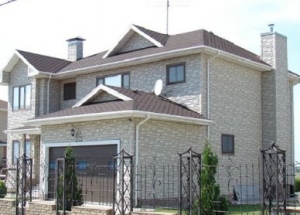Beautifully designed plinth gives the whole house not only a perfect architectural form, but also allows to keep the heat, protects the walls from penetration of moisture and accidental mechanical damage. So practical and beautiful in the design is the siding socket - a modern material for facing buildings, with high moisture and frost resistance, as well as good thermal insulation qualities.
Content
The socle (Italian Zoccolo) is the lower part of the building, its foot lying directly on the foundation and most often projecting beyond the outer plane of the walls. It should be said that the socle is most exposed to dampness and all kinds of damage. The facing material for this part of the building must be strong, durable and stable. At the same time, do not forget about the beauty and individuality of the building. High-quality finish of the sink of the socle helps to solve all these problems, the main thing is to choose the right kind of material and to properly perform its installation.
Advantages of socle siding
If it is necessary to finish the socle, specialists prefer socle siding. These are special strong and beautiful finishing panels that naturally imitate natural materials, but have a long service life and are unpretentious in care. Ground siding can be used not only directly for the purpose, but also for the walls of the entire house. With this material, you can finish the entire building, individual walls, socle, gables, columns or even flower pallets.
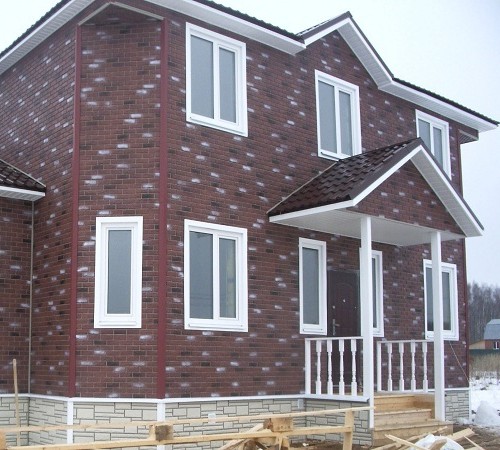
The plinth panels are denser, thicker and stronger than other types of siding, they are resistant to ultraviolet radiation, the effects of unfavorable weather conditions, corrosive environments, are inert to abrasive substances, are well cleaned with an ordinary detergent. The ground sidin gives the house a prestigious appearance - it is often not so easy to understand what exactly the house is lined with: natural material or siding panels. Such a finishing material is made from polyvinyl chloride (PVC) by injection molding. Thanks to this, a level of increased rigidity and strength is achieved. At the same time, such panels have a small weight, which simplifies and facilitates installation. The temperature range of the material is within the range of -50 0From to +50 0C. The texture of the socle siding is diverse, it repeats the forms of facing brick, natural stone or wood.

Finishing panels come in different colors, which are very stable and do not burn out in the sun for long periods of use. One of the important advantages of socle siding is the possibility, when assembling a combination with elements from other manufacturers of finishing material. Among the variety of siding, the best, rightly, is considered to be the sink siding finber (Fineber). Such panels are qualitative and practical, they most accurately imitate any natural materials, installation is quick and easy.
Variety of types of textures
Manufacturers offer different textural types of socle siding. These can be panels under:
- Facing bricks
- Natural stone, hewn stone, slate
- Tree
Attention! Buying a sink siding panel requires everything from one batch. The color tone of different batches may differ slightly. This is not very noticeable when buying, but will be very visible on the building. The number must be indicated on the packaging or on the labeling of the products.
Facing bricks
After the lining of the plinth with such panels, no one will guess from the first that this is just an imitation of a brick. That is why such an invoice takes the first place in popularity. Well-chosen and combined colors of panels give the house a beautiful view and satisfy any design ideas. Manufacturers offer more than 10 colors: beige, red, white, burnt bricks and others. This cladding is durable and reliable, does not crack with time, like a natural brick. Under the lining is easy to lay a heater, such walls are not covered in the winter with white salt fumes.
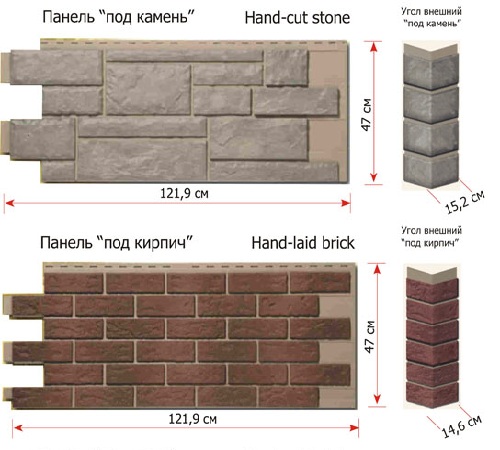
A natural stone
Facing the basement panels under the stone completely mimic the masonry made of stone. Basement siding under the stone well distinguishes architectural forms and zones. The plinth in this solution looks noble, the house combined with this decoration looks like old English buildings. In the market there are several coloring panels, perfectly repeating different types of natural stone. Siding socle, imitating slate or wild hewn stone, is produced in the same parameters as the facing under the stone. Beautifully looked houses, lined with light tones of stone with dark outer corners.
Basement siding for wood
This type of siding perfectly repeats the texture of the tree. Thanks to a special casting technology, it became possible to imitate the fibers (veins) inherent in the lining materials made of wood. Such siding can be used in any climatic zone, it is resistant to mechanical damages and unfavorable weather conditions. There is a wide variety of panels for a tree in the form of boards, fights or chips.

For example, very beautiful, noble and elegant looks at the houses finished with socle siding cedar board. The color scale of the veneer under the tree has more than 50 colors. Very good this type of siding panels is combined with other types: under a stone or facing brick.
Stages of installation of socle siding
The basement siding is very easy to mount with your own hands, it is quite a light and comfortable facing material. It does not create an additional load on the external floors, properly assembled panels serve about 50 years. Perhaps the only drawback of socle siding compared to the usual, is the greater consumption of materials due to the special mounting of panels. The panels are fastened to the crate.
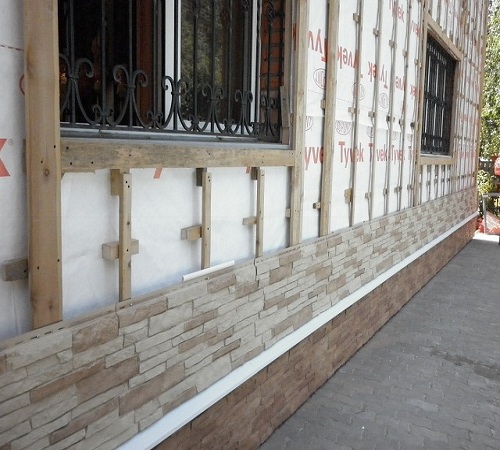
- Attention! To create a lath on the plinth, it is always necessary to use metal guides, wooden blocks near the ground will rot and will quickly become unusable.
The cladding is performed as follows:
- In the installation instructions for socle siding panels, the arrangement of both vertical and horizontal crates is acceptable. To mount the battens on the plinth, you must select a horizontal installation method. The step between the guides is 45 cm. When the building is faced with a vertical crate. The distance between the guides is not more than 90 cm.
- The height of the plinth of the plinth is exposed on the basis of design considerations and depending on the climatic conditions of the region. The more unfavorable the weather conditions, the higher the basement.
- All elements are attached with dowels, if the walls are brick. The faces of the metal guides or bars that will come into contact with the basement siding sheets must lie in the same plane.
- Framing is necessary for all windows and doors, at the same time all platbands, drainpipes, cornices are removed.
- Attention! When installing, you must use the building level. Correct installation of the lath will affect the quality of installation of all the plinth siding panels.
All auxiliary accessories must be branded, it is best to buy it with a margin in case of loss or miscalculation. Cut socle siding must be very carefully. This can be done as a Bulgarian or a hydraulic scissors, or an ordinary metal hacksaw.
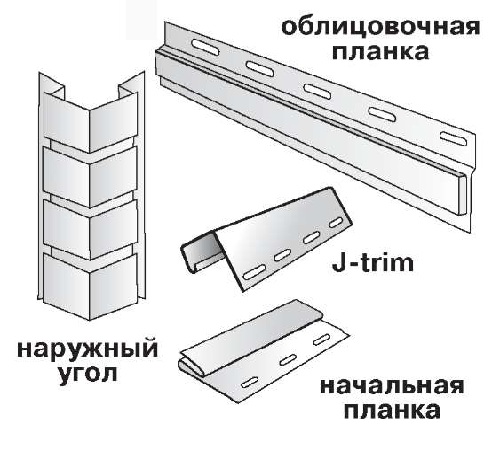
Mounting of socle siding on the lathing
Complex of works:
- Beginning with the installation of the starting rack. Ground siding has an individual profile of the starting strip. It is fixed exclusively horizontally. In the case of freezing ground, the starting rail is raised at least 20 cm above the ground, in the warm regions the guide is exposed directly from the ground.
- Further from the guide on all corners of the house vertically raise the fixing angular connecting elements. For internal corners a J-profile is used.
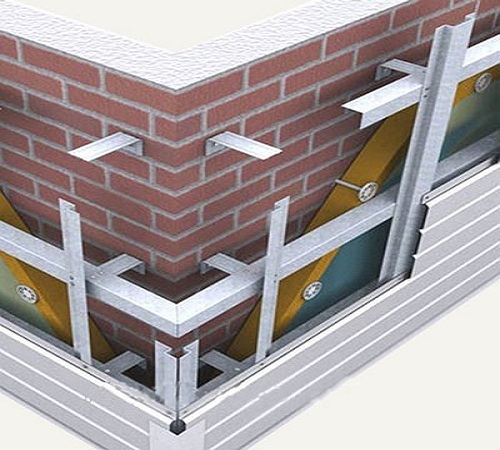
- Both slats and panels are attached using galvanized self-tapping screws with a thermowell or galvanized nails. Their length is not less than 40 mm, the diameter of the cap is 8 mm, the rod is 3 mm. When using nails, 100% work will be done manually.
- Self-tapping screws and nails are not brought to a stop. Between them and the slats leave a gap of 1-1.5 mm (you can put a penny coin).
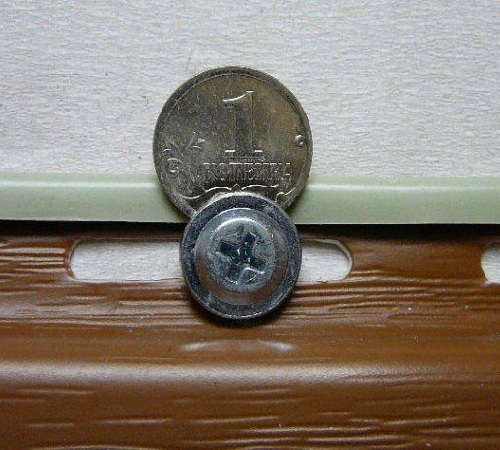
- Facing the basement panels during operation expand and contract, so when installing a free attachment is used. With the same purpose and for the outlet of condensate at the joints and corners of the building, gaps of 5-10 mm are left. This will not be noticeable, since the gap will be closed by the corner-platband. When installing the screws, it is enough to completely screw in the screw, and then turn it one turn back. If you subsequently have to remove the panels - the self-tapping tool is easier to dismantle than the nail.
- The installation of the socle panels starts from left to right, it depends on the latch, and always from the bottom up.
- The basement siding under the brick is cut at the left edge for an even edge. When imitating a stone cut in any place so that the overall pattern of the masonry was preserved.
- The first siding panel (evenly trimmed) is wound into the groove of the angular profile. The bottom of the panel is hooked to the hook on the starting strip. The panel snaps into place by moving it up.
- The panel should move freely in the lock to the left - to the right.
- Between the angled profile and the end of the panel a thermal gap is set. Then fix the siding to the crate.
- The next panel is joined to the previous one by means of grooves. It is also snapped onto the starting rail and fixed.
- The last row in the row is cut, inserted into the corner profile, snapped and fastened to the crate.
- Next, a complete installation of the siding on the base is performed. Finish work by installing the finishing strip.
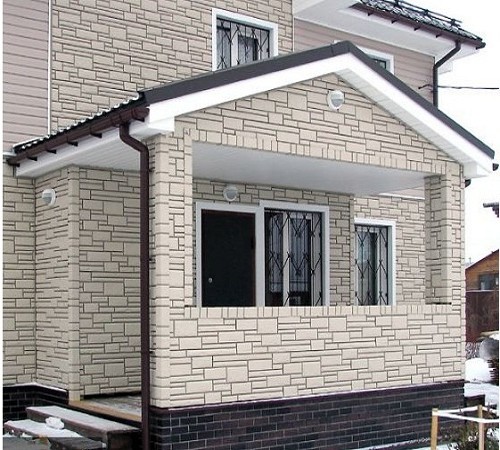
Installation of the socle siding with your own hands is not difficult, although this work is quite painstaking. It is very important to follow the instructions carefully and not to miss important nuances in the correct fastening of the panels. A detailed video of the plating of the house by the socle siding will help to understand all the nuances of the installation, to make the cladding as qualitative and beautiful as possible.


